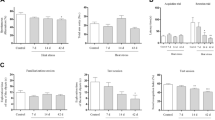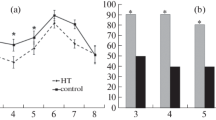Abstract
Heatstroke is defined as a core body temperature that rises above 40.6°C and is accompanied by mental status abnormalities such as delirium, convulsions, or coma resulting from exposure to environmental heat. There is fairly wide agreement that ethanol intake is a predisposing factor in heatstroke. This study was performed to identify the brain changes induced by heatstroke, using a mouse hyperthermia model with and without preceding ethanol administration. Exposure to heat of 42°C until the core temperature reached to 43°C followed by exposure to 37°C for 15 min decreased the levels of partial pressures of O2 in blood. Preceding ethanol administration and heat exposure induced hypotension, severe metabolic acidosis and respiratory failure, and, accordingly, produced heatstroke. Immunohistochemistry of the brains showed that preceding ethanol administration increased the number of c-fos-immunoreactive neurons, as a marker of neuronal activation, in the central amygdaloid nucleus, which is involved in thermoregulation. These results indicate that combined effects of ethanol and heat exposure induce heatstroke that is associated with activation of the central amygdaloid nucleus, implicating the pathophysiology and mechanisms of heatstroke under the influence of ethanol intake.




Similar content being viewed by others
References
Centers for Disease Control and Prevention (1995) Heat-related mortality—Chicago, July 1995. MMWR Morb Mortal Wkly Rep 44:577−579
Bouchama A, Knochel JP (2002) Heat stroke. N Engl J Med 346:1978−1988
Dematte JE, O’Mara K, Buescher J, Whitney CG, Forsythe S, McNamee T, Adiga RB, Ndukwu M (1998) Near-fatal heat stroke during the 1995 heat wave in Chicago. Ann Intern Med 129:173−181
Green H, Gilbert J, James R, Byard RW (2001) An analysis of factors contributing to a series of deaths caused by exposure to high environmental temperatures. Am J Forensic Med Pathol 22:196–199
Centers for Disease Control and Prevention (1998) Heat-related mortality—United States, 1997. MMWR Morb Mortal Wkly Rep 47:473–476
Ng’walali PM, Kibayashi K, Yonemitsu K, Ohtsu Y, Tsunenari S (1998) Death as a result of heat stroke in a vehicle: an adult case in winter confirmed with reconstruction and animal experiments. J Clin Forensic Med 5:183–186
Hannuksela ML, Ellahham S (2001) Benefits and risks of sauna bathing. Am J Med 110:118–126
Gulli LF, Mooney M (2005) Alcohol-related neurological disease. In: Chamberlin SL, Narins B (eds) The Gale encyclopedia of neurological disorders. Thomson Gale, Detroit, pp 25–29
Kane AB, Kumar V (2005) Environmental and nutritional pathology. In: Kumar V, Abbas AK, Fausto N (eds) Pathologic basis of disease. 7th edn. Elsevier, Philadelphia, pp 415–468
Sagar SM, Sharp FR, Curran T (1988) Expression of c-fos protein in brain: metabolic mapping at the cellular level. Science 240:1328–1331
Ceccatelli S, Villar MJ, Goldstein M, Hökfelt T (1989) Expression of c-Fos immunoreactivity in transmitter-characterized neurons after stress. Proc Natl Acad Sci U S A 86:9569–9573
Herring BE, Mayfield RD, Camp MC, Alcantara AA (2004) Ethanol-induced fos immunoreactivity in the extended amygdala and hypothalamus of the rat brain: focus on cholinergic interneurons of the nucleus accumbens. Alcohol Clin Exp Res 28:588–597
Papasozomenos SC (1996) Heat shock induces rapid dephosphorylation of τ in both female and male rats followed by hyperphosphorylation only in female rats: implications for Alzheimer’s disease. J Neurochem 66:1140–1149
Hung C-H, Chang N-C, Cheng B-C, Lin M-T (2005) Progressive exercise preconditioning protects against circulatory shock during experimental heatstroke. Shock 23:426–433
Keiver K, Duggal S, Simpson ME (2005) Ethanol administration results in a prolonged decrease in blood ionized calcium levels in the rat. Alcohol 37:173–178
Paxinos G, Franklin KBJ (2001) The mouse brain in stereotaxic coordinates, 2nd edn. Academic, San Diego (fig. 44)
Shieh S-D, Lin Y-F, Lin S-H, Lu K-C (1995) A prospective study of calcium metabolism in exertional heat stroke with rhabdomyolysis and acute renal failure. Nephron 71:428–432
Tsay H-J, Li H-Y, Lin C-H, Yang Y-L, Yeh J-Y, Lin M-T (1999) Heatstroke induces c-fos expression in the rat hypothalamus. Neurosci Lett 262:41–44
Harikai N, Tomogane K, Sugawara T, Tashiro S (2003) Differences in hypothalamic Fos expressions between two heat stress conditions in conscious mice. Brain Res Bull 61:617–626
Herman JP, Figueiredo H, Mueller NK, Ulrich-Lai Y, Ostrander MM, Choi DC, Cullinan WE (2003) Central mechanisms of stress integration: hierarchical circuitry controlling hypothalamo-pituitary-adrenocortical responsiveness. Front Neuroendocrinol 24:151–180
Tkacs NC, Li J, Strack AM (1997) Central amygdala Fos expression during hypotensive or febrile, nonhypotensive endotoxemia in conscious rats. J Comp Neurol 379:592–602
Weidenfeld J, Itzik A, Goshen I, Yirmiya R, Ben-Hur T (2005) Role of the central amygdala in modulating the pituitary–adrenocortical and clinical responses in experimental herpes simplex virus-1 encephalitis. Neuroendocrinology 81:267–272
Davis M (1992) The role of the amygdala in fear and anxiety. Annu Rev Neurosci 15:353–375
Almeida MC, Steiner AA, Coimbra NC, Branco LGS (2004) Thermoeffector neuronal pathways in fever: a study in rats showing a new role of the locus coeruleus. J Physiol 558:283–294
McBride WJ (2002) Central nucleus of the amygdala and the effects of alcohol and alcohol-drinking behavior in rodents. Pharmacol Biochem Behav 71:509–515
Graham JC, Hoffman GE, Sved AF (1995) C-Fos expression in brain in response to hypotension and hypertension in conscious rats. J Auton Nerv Syst 55:92–104
Chen C-M, Hou C-C, Cheng K-C, Tian R-L, Chang C-P, Lin M-T (2006) Activated protein C therapy in a rat heat stroke model. Crit Care Med 34:1960–1966
Bratincsák A, Palkovits M (2004) Activation of brain areas in rat following warm and cold ambient exposure. Neuroscience 127:385–397
Jones AW (2008) Ultra-rapid rate of ethanol elimination from blood in drunken drivers with extremely high blood-alcohol concentrations. Int J Leg Med 122:129–134
Fracasso T, Brinkmann B, Beike J, Pfeiffer H (2008) Clotted blood as sign of alcohol intoxication: a retrospective study. Int J Leg Med 122:157–161
Acknowledgments
This study was supported by a grant from the Japan Society for the Promotion of Science (16390195 to Dr. Kibayashi).
Author information
Authors and Affiliations
Corresponding author
Rights and permissions
About this article
Cite this article
Kibayashi, K., Nakao, Ki. & Shojo, H. Hyperthermia combined with ethanol administration induces c-fos expression in the central amygdaloid nucleus of the mouse brain. A possible mechanism of heatstroke under the influence of ethanol intake. Int J Legal Med 123, 371–379 (2009). https://doi.org/10.1007/s00414-008-0278-7
Received:
Accepted:
Published:
Issue Date:
DOI: https://doi.org/10.1007/s00414-008-0278-7




